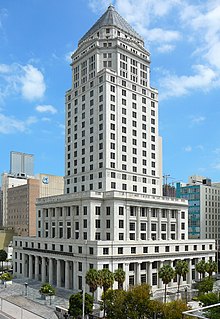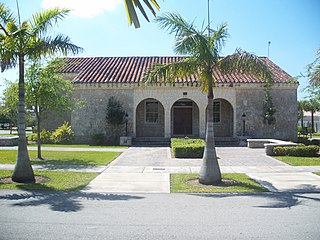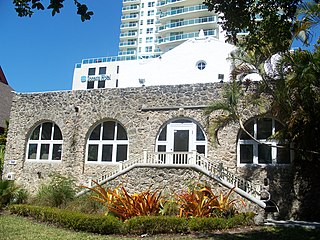
The Freedom Tower is a building in Miami, Florida, designed by Schultze and Weaver. It is currently used as a contemporary art museum and a central office to different disciplines in the arts associated with Miami Dade College. It is located at 600 Biscayne Boulevard on the Wolfson Campus of Miami Dade College. On September 10, 1979, it was added to the U.S. National Register of Historic Places. It was designated a U.S. National Historic Landmark on October 6, 2008, for its role in hosting services for processing Cubans fleeing to Florida. On April 18, 2012, the AIA's Florida Chapter placed the building on its list of Florida Architecture: 100 Years. 100 Places as the Freedom Tower / Formerly Miami News and Metropolis Building.

Virginia Key is an 863-acre (3.49 km2) barrier island in Miami, Florida, United States in Biscayne Bay, south of Brickell and north of Key Biscayne. It is accessible from the mainland via the Rickenbacker Causeway.

The Miami City Hospital, Building No. 1 is a historic hospital in Miami, Florida. The historic hospital, which is also known as The Alamo is located at 1611 Northwest 12th Avenue. On December 31, 1979, the building was added to the U.S. National Register of Historic Places. It is known today as Jackson Memorial Hospital.

The Miami-Dade County Courthouse, formerly known as the Dade County Courthouse, is a historic courthouse located at 73 West Flagler Street in Miami, Florida. Constructed over four years (1925–28), it was added to the U.S. National Register of Historic Places on January 4, 1989. The building is 361 feet tall with 28 floors. When it was built, it was the tallest building in Miami and in Florida.

The Lily Lawrence Bow Library is a historic library in Homestead, Florida. It is located 212 Northwest 1st Avenue. On August 5, 1996, it was added to the U.S. National Register of Historic Places. It was named after Lily Lawrence Bow, Homestead's first librarian.

El Jardin is a house located at 3747 Main Highway in Miami, Florida. It is listed on the U.S. National Register of Historic Places. El Jardin is now home to Carrollton School of the Sacred Heart in Miami, Florida. It was added to the U.S. National Register of Historic Places on August 30, 1974.

The First Coconut Grove Schoolhouse is a historic school located within City of Miami limits, in Dade County, Florida. The school originally resided at 2916 Grand Avenue, Miami, Florida, 33133. The structure was built in 1887, by Coconut Grove pioneer, Charles Peacock. Peacock reportedly constructed the house using wood gathered from ships wrecked in nearby Key Biscayne. The building originally served as a community gathering place, with Sunday School as its main purpose.

Coral Gables Preparatory Academy, formerly Coral Gables Elementary School, is a public K-8 school in Coral Gables, Florida. A part of the Miami-Dade County Public Schools, it has its elementary school classes in the Lower Academy, in the former Coral Gables Elementary building, while the middle school classes are in the Upper Academy at the Merrick Educational Center. The school was given its current name in 2010.

The Coral Gables Woman's Club is a historic woman's club in Coral Gables, Florida. It is located at 1001 East Ponce de Leon Boulevard. On March 27, 1990, it was added to the U.S. National Register of Historic Places.

The Lemon Bay Woman's Club is a historic woman's club in Englewood, Florida, United States. It is located at 51 North Maple Street. On August 11, 1988, it was added to the U.S. National Register of Historic Places.
The Lemon Bay Woman's club was organized by Dr. Mary Green who was a school teacher in Englewood. Originally named the Lemon Bay Mother's Club, a name retained until April 1924, the club played an important role in the development of the religious, educational, civic and political life of Englewood. Construction on the prairie style clubhouse was begun in September 1925 on two lots donated in Lampp subdivision by A. Stanley and Winifred E. Lampp. Englewood, incorporated in 1925, and the surrounding area then boasted 300 residents.
Sarasota architects Thomas Reed Martin and Clare C, Hosmer, formerly of Chicago, donated their design services for the building. Carpenters Pat Lampp, Fred Clark, and Leroy Bastedo were responsible for the clubhouse construction. The building originally consisted of a screened veranda and one large meeting room featuring a brick fireplace and a semi-circular stage, for which total construction cost was 3,120. A housewarming held on February 19, 1926, attracted 200 persons. Official incorporation, a year later, occurred under the direction of Charlotte Wellington, president.
In 1922, under the leadership of Mrs. Hallie Green, members started a school library and maintained a lending library at the club until 1962. Surviving the depression and the loss of its $37 treasury when banks failed, the club continued to hold fish fries, nature study classes, dances, card parties, plays, musical programs, travelogues and lectures. The club retired its mortgage on February 24, 1938. The note was burned at a gala meeting on March 4, 1938
Between 1926 and 1970, the club served as a sanctuary for many Englewood churches and as a meeting place for various organizations. The Englewood Community Church was the first congregation to meet at the club. Others included the Community Presbyterian Church, First Baptist Church, St. Raphael's Catholic Church, St. David's Episcopal Church, Evangelical Free Church, Church of God, Church of Christ, First Methodist Church, and Calvary Baptist Church. During World War II the building was turned over to the American Red Cross. The club was the first building in Englewood to be listed in the National Register of Historic Places.

The Congress Building, or simply the Congress Building, is a historic skyscraper in Downtown Miami, Florida, United States. It is located at the address of 111 Northeast 2nd Avenue. The Congress Building was added to the National Register of Historic Places on March 14, 1985, and is locally identified a historic site in the Downtown Miami Development of Regional Impact (DRI). The Congress Building was formerly office space until 1999, when it was restored and converted to apartments. At street level, the building contains retail space which is leased to a number of stores and services including a financial establishment, The Loft condo sales center, beauty salon and café. Originally the building was five stories; the additional 16 were added on later.

The Miami Women's Club is a historic site in Miami, Florida. It is located at 1737 North Bayshore Drive. On December 27, 1974, it was added to the U.S. National Register of Historic Places.

August Geiger was one of the most prominent American architects in South Florida from 1905 to the late 1940s. He experimented in Mission, Neo-Renaissance and Art Deco architecture, but is most noted for his works in the Mediterranean Revival style. A number of his works are listed on the U.S. National Register of Historic Places.

The Woman's Club of Coconut Grove is a historic woman's club in Miami, Florida.

The Lend-A-Hand Club was located in downtown Davenport, Iowa, United States, along the riverfront. It was listed on the National Register of Historic Places in 1983.

The Coco Plum Woman's Club is a historic women's club located at 1375 Sunset Drive in Coral Gables, Florida. The club was founded in 1912 with eight members; it was named for the local cocoplum fruit. While the club was originally based in one of its members' houses, it built its own clubhouse in 1913. Its historic Mediterranean Revival clubhouse was built in 1926. The club participated in homefront efforts during both World Wars; its work with the American Red Cross during World War II was well-regarded within Florida. During peacetime, the club has served as a community library, a social venue for meetings and dances, a clinic, and a pre-school.

Miami City Hall is the local government headquarters for the City of Miami, Florida. It has been located in the former Pan American Airlines Terminal Building on Dinner Key, which was designed by Delano & Aldrich and constructed in 1934 for the former International Pan American Airport, since 1954. The city's government headquarters originated in Downtown Miami for 58 years until its relocation to Coconut Grove.

The Silver City Woman's Club is a historic women's club located at 411 Silver Heights Boulevard in Silver City, New Mexico. The club was founded in 1909, and it built its meeting house in 1935–36. Richard Tatsch designed the clubhouse in the Pueblo Revival style, which reflected the region's architectural history. The clubhouse provided two spaces for the club's community activities and private meetings; the former included distributing food to needy families and conducting child welfare inspections on behalf of the state, while the latter included self-improvement courses in music and literature. The women's club has continuously held its activities in the building since its construction; it has also provided a space for community meetings and large events.

The Country Woman's Club was founded in the unincorporated community of St. Bethlehem, Tennessee in 1922, as a monthly meeting at one of the member's houses. It expanded to 35 members who eventually moved to meet at the White's Creek Chapel School.





















